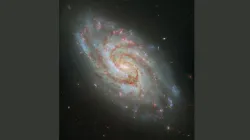NASA's Hubble telescope reveals stunning Spiral Galaxy in deep space
The collaboration between Hubble, James Webb, and ALMA marks a new era of space observation, as scientists continue to unlock the mysteries of the cosmos through detailed imagery and powerful data.

NASA’s Hubble Space Telescope has reportedly delivered a spectacular image of the spiral galaxy IC 1954, which is located 45 million light-years away in the constellation Horologium. The new image showcases a captivating view of the galaxy’s structure, star-forming regions, and intricate spiral arms, that provide deeper insights into how stars are born and evolve within galaxies.
A glimpse into IC 1954: Star-forming regions and cosmic feature
The galaxy IC 1954 was seen from a diagonal angle, showcasing its bright core and spiral arms, which seem to sweep like a cosmic pendulum. The pink patches visible in the image are star-forming regions, filled with hydrogen-rich areas where stars are actively being created. These glowing areas add vibrancy to the galaxy’s disc and offer astronomers an opportunity to study the process of stellar formation in detail.
A collaborative effort: Data from 3 advanced telescopes
This incredible observation of IC 1954 was made possible by combining data from three powerful telescopes: NASA’s Hubble Space Telescope, the James Webb Space Telescope, and the Atacama Large Millimeter/submillimeter Array (ALMA) in Chile. The synergy between these instruments has allowed for an unprecedented view of over 50 nearby galaxies, including IC 1954.
Each telescope contributed its unique capabilities, capturing data across radio, infrared, optical, and ultraviolet wavelengths. These wavelengths reveal how matter interacts with interstellar dust and gases, providing crucial information about galactic evolution and the life cycles of stars.
Star formation zones: Hubble’s role in revealing new stars
One of the key features of the Hubble image is the H-alpha data, marked by red regions that indicate areas rich in hydrogen, where stars are being actively formed. Some astronomers suggest that the bright ‘bar’ across the galaxy could be a particularly active star-forming zone located near the galactic centre.
Hubble’s ability to observe in ultraviolet and optical wavelengths allows it to capture young stars and clusters in their most active phases, which is essential for understanding how stars evolve. This data, combined with the ongoing observations from the James Webb Space Telescope, will continue to push the boundaries of our knowledge about galaxies and their formation.
Expanding our understanding of the universe
With this new image of IC 1954, NASA and the European Space Agency (ESA) are expanding our understanding of how galaxies evolve and how star formation drives that evolution. The observations provide an important foundation for ongoing research into the movement of matter in galaxies and the forces shaping the universe.
ALSO READ: James Webb Space Telescope uncovers distant galaxy offering clues to the Early Universe
ALSO READ: SpaceX launches rescue mission for NASA astronauts Sunita Williams and Butch Wilmore stuck in space